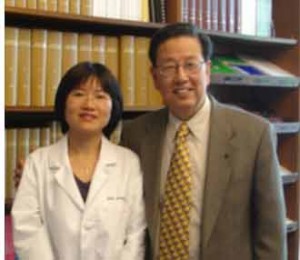Research Experience 2007 3-Dimensional Knee Modeling – Where Laboratory Meets Patients

From last summer, I started the project for my Ph.D. thesis – “A Subject-Specific Finite Element (FE) Model of the Anterior Cruciate Ligament”. This work aimed to build a FE model of the ACL based on its complicated anatomy and structure. The highlight was to obtain the irregular hourglass geometry of the ACL as well as its spiral fiber orientation, which induces the transverse isotropy of the ACL, and incorporate these important features into the FE model. Kuka, our sophisticated robotic/universal force moment sensor (UFS) system, was used to apply two external loading conditions simulating clinical exams. The kinematics was recorded by using the registration blocks and input into the model as boundary conditions. The measured ACL force was used as an indirect measure to validate the FE model. Our next step is to measure the ACL strain by tracking the markers on the ACL surface using digital motion analysis camera system. The measured ACL strain will serve as a direct measure to validate the model. This work has been going well under Dr. Woo’s guidance, and with a lot of help from other members at the MSRC. Dr. Changfu Wu gave me a lot of constructive suggestions and helped me tackle down a lot of technical obstacles. Mr. Noah Lorang helped me to operate the robotic, and Dr. Giovanni Zamarra assisted me with surgical procedures. Dr. Richard Debski and Nicholas Drury, B.S. shared their extensive knowledge in computational modeling. Without their help, this work could hardly be done.
Besides that, I was also involved in the Achilles tendon project with Ms. Caressa Watson and Mr. Chris Uhrinek. The objective of this study was to separately determine the mechanical and viscoelastic properties of the three canine Achilles tendon bundles to assess the variations between them. The results can be utilized as a basis for future Achilles tendon healing studies. We did it with a lot of fun from the very beginning of practice with the help from Noah Papas, M.S. and Matthew Fisher, B.S. on the biomechanical testing. Dr. Chin-Yi Chuo also helped us with dissecting the tendons. This project was under Dr. Steve Abramowitch’s guidance. Thanks for all his help and instruction.
I would like to take this opportunity to thank the ASIAM Institute for financial support. Thanks Dr. Woo for giving me such great support and tireless guidance. And thank all the MSRC members for their help and friendship!

